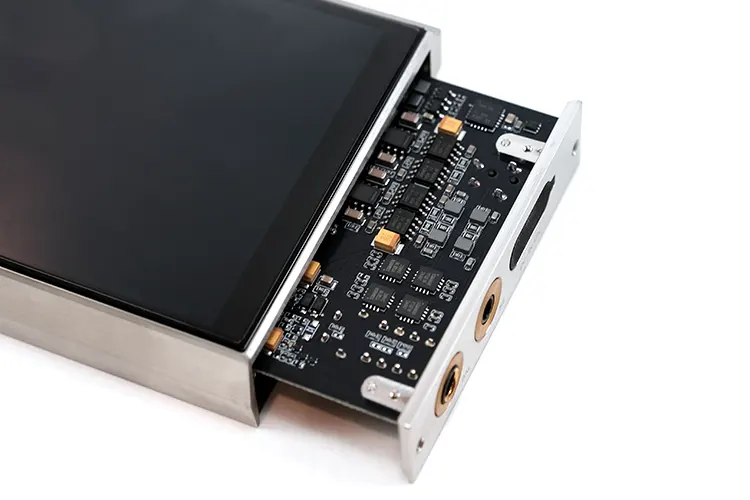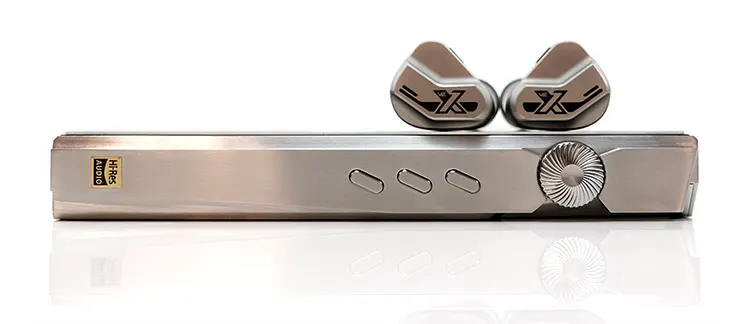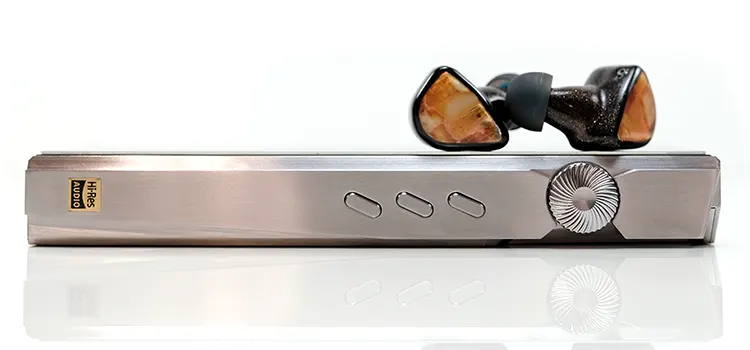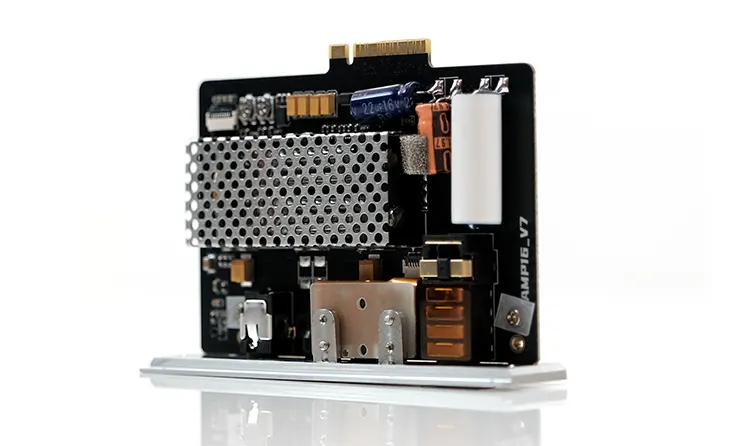Sound Impressions
The sound impressions of the iBasso DX340 were completed using a mix of the PMG Audio Apx, Vision Ear’s VE10, Unique Melody’s Maven II, and the Meze Audio POET.
AMP15 Summary
The AMP15 is the more neutral and linear of the two available AMP cards, though not as cold sounding as the previous stock card from the DX320, the AMP11 MKII S.
iBasso has taken a lot of learning from the D16 and injected it into the AMP15, creating a very holographic soundstage with excellent imaging and a more natural tonal balance, particularly in the upper mids and highs.
Arguably, the DX340/AMP15 combo sounds like it has taken a little bit of the rougher edges from the AMP11 MKII S/DX320 performance, creating a much improved tonal balance for higher-pitched, more delicate vocals with feistier IEMs such as the PMG Audio Apx.
So you get that same effortless airy quality but with reduced sibilance and less of a heavy emphasis on leading edges from high-energy percussion strikes. As a result, it flows very smoothly but with bags of detail and a nice, even amount of tonal contrast.
However, my tip is to play with the gain levels, even with IEMs, because combined with the Harmonic filters, you can enhance the DX340/AMp15 even more.
Particularly so with the DAC high gain setting, which brings out a higher level of vocal bloom and vividness in the mids and highs. I would almost keep that on by default. Once you turn it off, the mids on IEMs, such as the VE10, start to sound muted by comparison.
It’s a similar approach with headphones, though I would opt for DC-In Super Gain by default. In pure battery mode with a high gain setting across the board, AMP15 can drive most headphones, but the dynamic lift and perceived power from a wired DC-In Super Gain mode is palatable with the likes of the Meze Audio POET.
AMP16 Summary
AMP16 is the more colored of the two cards. Perhaps not as spacious as AMP15, but it brings a wider variety of flavors to the table.
In Class AB mode, the DX340 will sound a little drier but more energetic and immediate, with a punchy character through the lows. Combined with a DAC high gain setting, mids have a high level of contrast, though treble overtones are still beautifully controlled.
It’s an excellent mode for recordings with a rapier-like BPM and fast-paced rhythm guitar work, particularly so with headphones such as the POET in DC-Gain mode. Also, compared to tube mode, I felt the vocals imaged a bit further forward, though not as smooth and fulsome sounding.
In Tube mode, the presentation stands back a bit from the more attack-minded Class AB, creating a more spacious soundstage, slightly deeper in the lows with a smoother set of mids and highs.
Vocals are set a bit further back to my ear with tube mode. They sound richer and fuller than more neutral Class AB performance, but slightly more recessed with my tested gear.
This is an excellent setting for brighter headphones where you do not want to draw too much focus on high-pitched percussion strikes and keep the vocal sibilance to a minimum.
Headphones such as the DCA Noire X paired particularly well with the DX340/AMP16 tube mode setting, creating a strong but smoother midrange performance than AB.
Harmonic Controls
The DX340 harmonic filters are quite noticeable with both AMP cards. H1 and H2 are the widest, most spacious of the 5 options, though if you are after bass weight and thrust, they might sound a little linear with AMP15.
H1 is perhaps the most neutral of the 5 filters, with H2 gently pushing the tonal balance to a slightly sweeter, more forgiving tone.
If you are after a fuller, more vibrant tone with AMP15, then H5 “All” delivers the best fundamental frequency with the thickest note quality. It sounded fantastic with big staging beats like the BOKEH, which needs plenty of ‘fill’ to sound complete.
It can sound a bit full-on with smaller soundstages, such as the VE10, and I did find myself switching back to H1 or H2 with this monitor to lower the intensity and create a bit more perceived space.
H3 and H4, ‘even’ and ‘odd’ are exactly that. H3 suits headphones that can be quite revealing in the mids and highs, so if you want to lower percussion strike emphasis, then it’s an excellent filter, though it can come at the cost of a little headroom.
H4 puts a little more emphasis on note attack and shines more light on treble overtones in any recording. It’s not a huge flip to the bright side, but it works well with warmer IEMs and AMP16’s tube mode, particularly with a high-gain DAC setting.
Synergy
Noise Floor
How low is the DX340 noise floor? The answer is that it depends on the AMP card you are using.
AMP16’s tube mode’s background hiss is a little more noticeable, especially on a high gain setting with sensitive IEMs such as the Vision Ears VE10. However, given its dual Jan tube setup, the performance is very good with no tube ping on low gain
Class AB mode from AMP16 is very quiet, as is AMP15 in all gain modes except for DC-In Super Gain mode using the same VE10 pairing via a balanced output connection.
If you opt for DC-In Super Gain and keep everything on a high gain setting, you will hear plenty of background noise with IEMs. I would save this mode for more demanding headphones and high-load inefficient flatheads.
DC-In Super Gain works best with IEMs using AMP15 and keeping the amp gain mode low with DAC Gain set to high. This seems to tease out more midrange vibrancy and treble contrast.
This gives it a more exciting and sparkling tone (H1) without pushing too hard on the volume, which is what will happen if you also use a high gain setting from the AMP side.
AMP16’s DC-In Super Gain performance in Tube mode over regular gain using PMG Audio’s Apx sounds like it delivers a more noticeable uplift in dynamics, requiring more volume adjustment to compensate when compared to Class AB mode’s more controlled presentation.
Volume control and channel balancing on low volume levels are excellent for both cards, regardless of gain setting.
IEM Pairings
With AMP16, I would opt for Class AB with most of the IEMs I tested if you are listening to EDM recordings.
The VE10 and Maven II’s low-end performance was vibrant sounding, with excellent definition and a short decay suitable for fast-paced, punchy bass notes.
I would also pick Class AB with the VE10 over Tube Mode. Class AB’s cleaner tonal qualities better suit the warmish VE10 presentation, whereas the Tube mode did better with the sparkling highs of the Apx.
Tube mode will smoothen the edges and deepen the soundstage, especially if you find Class AB more sibilant for more mids-oriented percussion or vocals.
I also noticed that staging was more ‘aloof’ when using the Maven II in Tube mode. It is deeper sounding than Class AB but a bit further removed from the listener. Vocal separation in Tube mode was superior to Class AB, giving vocalists more presence and richer, fulsome character.
I must stress again: try all pairings with AMP16 using a high DAC gain setting, as this teases out more treble sparkle and tonal contrast. Vibrancy through the mids is more noticeable with all IEM pairings using this setting.
AMP15 is the high-fidelity pairing, particularly suited to gear with a high degree of technical capability and/or a spacious soundstage quality. Perhaps not as an exuberant pairing as AMP16 for EDM, it more than makes up for this in terms of nuanced micro-detail retrieval.
Of the IEMs tested, the PMG Audio Apx was by far my favorite with AMP15, producing stellar imaging with excellent staging width and height.
Using a high-gain DAC setting combined with Harmonic 5 “All” and DC-In Super Gain mode, you also get an improved sub-bass response with a juicier midrange timbre, making it the most complete pairing tested.
AMP15 Headphone Pairings
I tested three headphones with AMP15, the DCA Noire X, Meze Audio’s POET, and the ZMF Headphones BOKEH.
In each instance, there was no issue driving any of the three headphones, but if you want the most dynamic sound, then I would pick high gain for amp or high DAC combined with the DC-In Super Gain mode.
The DAC in high gain mode gives me what I crave in terms of midrange bloom and a bit of contrast, whereas, unlike the IEMs where it is not required, the AMP high gain setting produces a bit more power and snap, especially on the lows.
However, AMP15’s DC-In Super Gain has the most impact with all three headphones. Your final decision is what Harmonic filter you want to use, and that is where I found some differences.
For example, the POET sounds better with the original or natural Harmonic filter (H1 and H2). You get an airy tone, decent punch and weight, and excellent staging width from what is otherwise a relatively narrow soundstage.
The H5 “All” filter felt too dense and close for my taste with the POET. It seems to close the staging in a bit too much with less space for instruments and vocals.
The NOIRE X felt at home with H2 or H3, the natural or even harmonic filters. Primarily because it took the edge off the highs, giving it a smoother sound compared to the other filters.
With the BOKEH, I went with H5 because its staging expanse is huge and needs plenty of weight and power to sound optimal. The other filters felt a bit too light to suit my listening tastes for the BOKEH, whereas H5 produced a thicker, firmer presentation.
AMP16 Headphone Pairings
With DC-In Super gain and DAC gain in a high setting, it is going to come down to the choice of amp mode and harmonic filter for all three headphones.
With the Noire X, tube mode got my node or Class AB with the H3 even filter. Both created a smoother set of highs and tamed the fizz and sibilance in percussion and vocals more than the other filters.
I would pick AB with the Noire X if I wanted a bit more energy in the lows and a stronger vocal presence. The tube mode had a more relaxed and soothing sound.
For the BOKEH, Tube mode felt almost too relaxed. I would go with H5 “All” and Class AB to flesh out the vocal energy and bring their imaging a little bit closer in. The tube mode diminished the vocal presence a bit too much with the BOKEH for my tastes.
The POET is a sure-fire Class AB and H1 or H2 filter pick. It delivers the most spacious presentation with a shorter decay, which I find suits this headphone a bit more than the softer even filter. The tube mode sounded too soft for my liking, especially through the mids.







